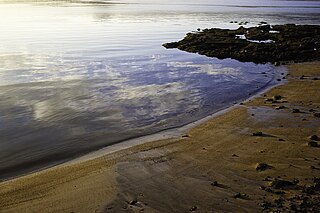History
The ancient sandy cove where Mollavao is located is the origin of the present-day neighbourhood. The name Mollavao comes from molle (wharf) and vao (place of unloading). Mollavao originated as a port area in the Roman Empire, serving as the outport of Pontevedra. The first known mention, as Mollia Vada, is from a document of 1220. [1] In 1595, it was already described in a plan kept in the General Archives of Simancas as a remarkable place in the ria of Pontevedra. [2]
In the first half of the 18th century, the Chapel of the Saints was built in the Baroque style in Mollavao. Its construction was ordered in 1737 by Juan De Marzoa to be dedicated to Saint Francis (whose stone statue was in a niche on the façade) and was completed in 1741. It was a baroque temple of Portuguese inspiration, surrounded by columns crowned with statues of saints (St. James, St. Joseph, St. John, St. Peter, St. Michael, St. Anthony, St. Martin, St. Lupus, the Virgin Mary and the Guardian angel). In the mid-19th century, it was abandoned and its architectural elements and statues were moved to other locations, including the cemeteries of Salcedo and Saint Maurus and the chapel of Saint Blaise. [3] [4]
In the mid-19th century, the overall connections between the city and other towns were improved and between 1847 and 1851, Oliva Street and the current Rosalía de Castro Street were built, the extension of which as a road connected the city to Marín through Mollavao. [5]
The Fabril Gallega de Jabones soap factory was set up in the Mollavao neighbourhood in 1938, at the current number 126 Rosalía de Castro Street. The building was designed by the municipal architect Emilio Quiroga Losada and remained in business until 1944, when its owner died. It produced everything from laundry products to bath and toilet soaps. Among the most famous were the San Justo salt soaps. [6] [7] [8]
In 1944, land was expropriated in the area for the construction of housing for naval officers working at the Naval Military Academy. [9] In Mollavao, on both sides of Rosalía de Castro Street, houses were built for this purpose, surrounded by green areas and gardens.
On 19 May 1947, the project to build a road along the Pontevedra ria between Pontevedra and the Placeres neighbourhood, in the civil parish of Lourizán, was approved. The work on this road, which began in 1949 and was completed in 1955, also modified the Mollavao creek, filling it completely with earth. [10] In 1969, the road was completed with four lanes of traffic and was opened as a four-lane road on 8 August 1969. [11] [12]
In 1948 the first tenants started to move into the social housing consisting of small colourful houses around Benito Vicetto Square. [13]
In 1953, the Juan Sebastián Elcano private school (belonging to the Ministry of Defence) was built in the neighbourhood, in Rosalía de Castro Street, next to the Navy's military housing, which began operating in 1954. [14]
On 26 September 1985, the Casa del Mar polyclinic health centre building was inaugurated in the Mollavao neighbourhood, with a total of 89 specialist doctors. [15]
On 21 December 1989, construction began on the AP-9 motorway bridge, the Ria Bridge, and the route of the motorway through the south and west of the city, which crosses the Mollavao neighbourhood on a viaduct and was opened on 25 March 1992. This highway has completely changed the appearance of the area. [16]
In the future, there are plans to build a wide street linking Rosalía de Castro Street to Marín Avenue on the former site of the circus in order to improve mobility in the area. [17] [18]
































